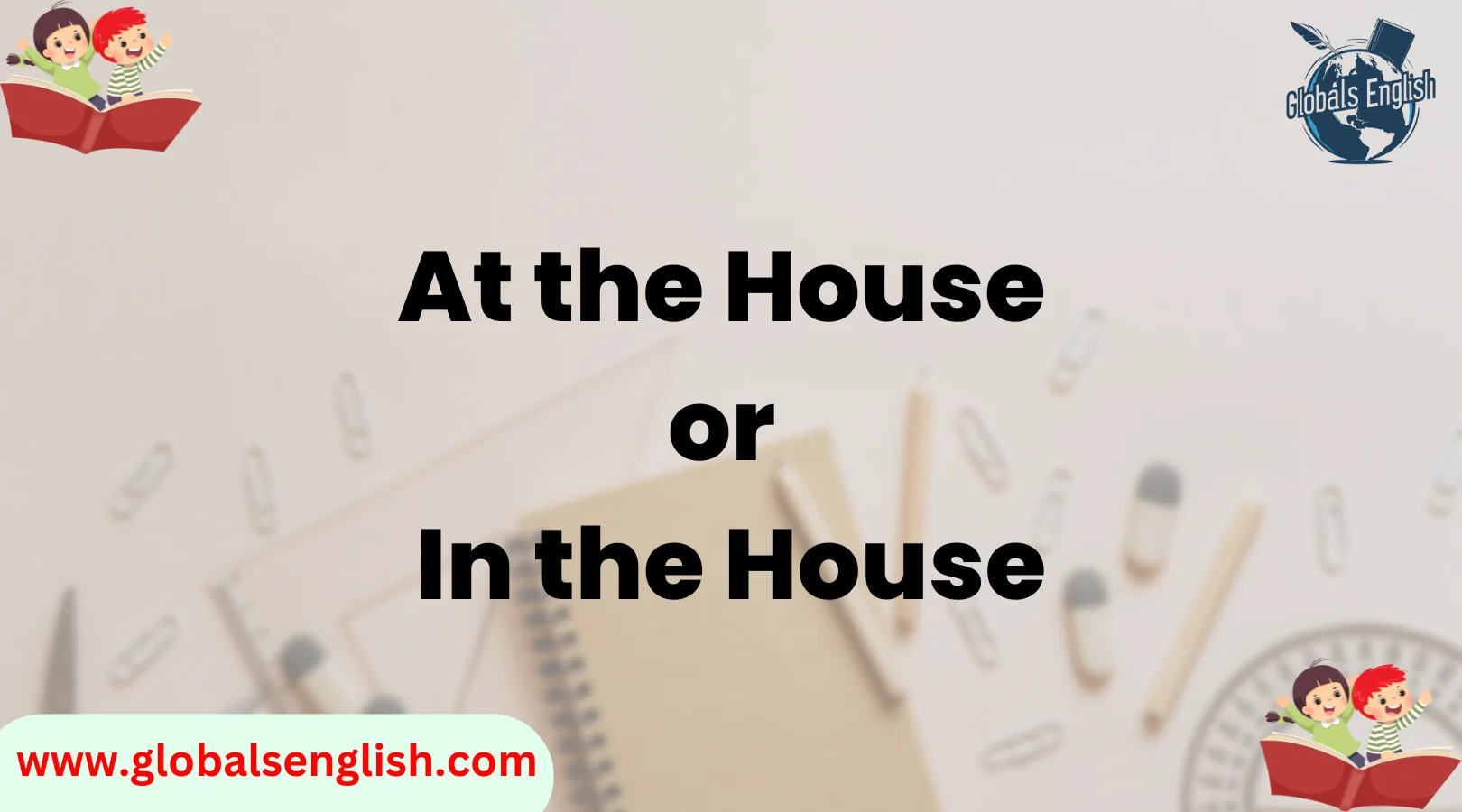If you’ve ever found yourself second-guessing whether to say “at the house” or “in the house,” you’re not alone. It’s a common conundrum in the English language. Prepositions like “at” and “in” are subtle but crucial parts of speech that can shape the meaning of a sentence. Whether you’re a native speaker or learning English as a second language, it’s important to understand when and why to use these prepositions.
In this article, we’ll break down the differences between “at the house” and “in the house,” discuss when each one is correct, and explain why context plays a huge role in your choice. Plus, we’ll provide real-life examples, common mistakes, and expert insights to ensure you use these phrases with confidence. Understanding the nuances of prepositions can significantly improve your communication skills, whether you’re writing an essay or casually chatting with friends.
By the end of this guide, you’ll not only know the correct usage of “at” and “in” but also gain a deeper understanding of prepositional language and how to wield it like a pro. So, let’s dive in!
What’s the Difference? Understanding Prepositions “At” and “In”
At its core, a preposition is a word that shows a relationship between a noun or pronoun and other parts of the sentence. While that sounds simple, prepositions like “at” and “in” can be tricky to master because they often overlap in meaning. Here’s a quick breakdown of each one:
- “At”: This preposition is used to point out a specific location or a particular point in space. It can also describe an event or purpose.
- “In”: This preposition is used when talking about inside a space or an enclosed area. It implies that something is contained within boundaries, such as a room, a box, or even a country.
The key difference is that “at” tends to describe more general or external positions, while “in” refers to something more specific or enclosed.
For Example:
- “I am at the house” means you are near or at the house, but you might not necessarily be inside.
- “I am in the house” means you are physically inside the house, within its walls.
When to Use “At the House”
1. Describing a Location or General Point
“At the house” typically refers to being in the vicinity or outside the house, rather than inside it. If you’re meeting someone at a specific address or point, this is the correct preposition to use. It can refer to a place you’ve arrived at or are close to, but not necessarily inside the building.
For example:
- “I’m at the house waiting for you.”
- “The meeting is at the house this afternoon.”
In both cases, “at the house” simply points to the location without specifying whether you’re inside or outside the building. It’s a general reference to the place, not a specific room or area inside.
2. Referring to an Event or Purpose
Another common use of “at the house” is to indicate that something is happening or someone is going to a location for a particular purpose. Whether it’s a party, a gathering, or a meeting, this preposition is often used when describing events that are taking place at someone’s residence.
For example:
- “The birthday party is at the house this weekend.”
- “We’re having a barbecue at the house tomorrow.”
In both cases, “at the house” refers to the event happening at that location, rather than describing where someone is physically positioned.
3. Describing External or Indirect Situations
“At the house” can also be used in more abstract or indirect contexts, where the action is happening near or around the house, but not necessarily inside.
For example:
- “I’m at the house to drop off the package.”
- “She is at the house to help with the chores.”
In these cases, “at” emphasizes the location rather than the internal structure of the house.
When to Use “In the House”
1. Referring to Being Inside the House
The phrase “in the house” is used when someone is physically inside the house. It’s the most straightforward usage and refers to the interior of the home. This preposition conveys that someone or something is enclosed within the building.
For example:
- “I’m in the house watching TV.”
- “She’s in the house making dinner.”
Both examples describe people being inside the structure of the house, within its walls, not outside or around the building.
2. Describing Enclosed Spaces Within the House
In addition to simply referring to the interior, “in the house” is also used when discussing specific enclosed areas inside the house. This could mean a room, hallway, or any other part of the home that’s not outside.
For example:
- “The bathroom is in the house.”
- “The keys are in the house.”
Both examples indicate a specific location inside the house, clearly distinguishing them from areas outside.
3. Referring to Large Structures or Complex Areas
In some cases, “in the house” can be used to describe a larger, more complex structure, often implying the house as a whole.
For example:
- “There are rooms in the house for every purpose.”
- “In the house, there’s a library and a gym.”
This highlights that you’re talking about areas within the house, including its overall structure and the different spaces inside it.
Common Confusion: “At the House” vs. “In the House”
It’s easy to mix up “at the house” and “in the house,” especially in informal speech. The two can seem interchangeable, but they each have specific contexts that make them correct in certain situations.
1. “At the House” vs. “In the House”
While both phrases describe a location near or at a house, the difference comes down to the specificity of the location.
- “I’m at the house” might mean you’re simply near the house, outside, or waiting.
- “I’m in the house” specifically means you’re inside the house.
2. Common Mistakes to Avoid
- Using “at” when you should use “in”: For example, “I’m at the house watching TV” is incorrect because you’re describing being inside, not just near or outside the house.
- Using “in” when you should use “at”: For example, “The party is in the house” might sound strange when the party is happening outside or near the house, but not inside.
Real-Life Examples of Each Phrase
To help clarify the difference further, let’s look at a few examples from everyday life. These examples show the appropriate context for both “at the house” and “in the house.”
1. “At the House”:
- “I’ll be at the house later to pick up my things.”
- “The concert is at the house this Friday.”
In these examples, “at the house” refers to the location where something will take place or where someone will be, without implying they’ll be inside.
2. “In the House”:
- “I’m in the house right now, so come on in.”
- “The dishes are in the house, not outside.”
Here, “in the house” emphasizes that the action is taking place inside the physical structure of the home.
Special Considerations: Idiomatic and Contextual Uses
In some idiomatic phrases, “at” and “in” can have special meanings that don’t follow the usual rules.
- “In the house” can sometimes refer to being part of a group, not just the physical house. For example, “She’s in the house” can imply that she’s part of a social group at an event.
- “At home” is a common expression that might seem similar to “at the house,” but it refers to the idea of being at one’s personal residence.
It’s important to remember that context plays a big role in determining whether “at” or “in” is appropriate.
How to Avoid Mistakes: Quick Tips and Tricks
To summarize, here are a few quick tips for avoiding mistakes when choosing between “at” and “in”:
- Use “at” when referring to a general location or event happening around or near the house.
- Use “in” when describing being inside the house or in a specific room within it.
- Always consider the context: Are you talking about a location, an event, or the interior of the house?
Conclusion: Mastering Prepositions for Clear Communication
Understanding when to use “at the house” and “in the house” isn’t just about getting grammar right; it’s about improving your overall communication. By choosing the correct preposition, you’ll make your speech and writing clearer and more precise, helping your listeners or readers easily understand your meaning.
Whether you’re casually talking to friends, writing an email, or even describing an event, knowing the nuances of these simple prepositions will help you avoid confusion and speak more confidently. Now, when you’re at the house or in the house, you’ll know exactly which phrase to use!
FAQs: “At the House” vs. “In the House”
1. Is “at the house” grammatically correct?
Yes, “at the house” is grammatically correct when referring to a general location or an event happening at that location. Example: “I’m at the house waiting for you.”
2. When should I use “in the house” instead of “at the house”?
Use “in the house” when you’re referring to something inside the house rather than just its location. Example: “She is in the house cooking dinner.”
3. Can “at the house” and “in the house” be used interchangeably?
Not always. If you’re inside the house, “in the house” is the correct choice. If you’re just near or at the location, “at the house” is better.
4. What’s the difference between “at home” and “at the house”?
- “At home” is more personal and refers to where someone lives: “She’s at home today.”
- “At the house” refers to a physical location, not necessarily where someone lives: “The plumber is at the house.”
5. Is “at the house” more common in British or American English?
Both British and American English use “at the house” and “in the house” in similar ways. However, in casual American speech, people might say “at home” more often than “at the house.”
6. Can I say “inside the house” instead of “in the house”?
Yes! “Inside the house” emphasizes being within the walls, but “in the house” is more commonly used in everyday conversation.

As the visionary founder and CEO of Globals English, Emma Brooke is dedicated to transforming the way individuals learn and master the English language.
